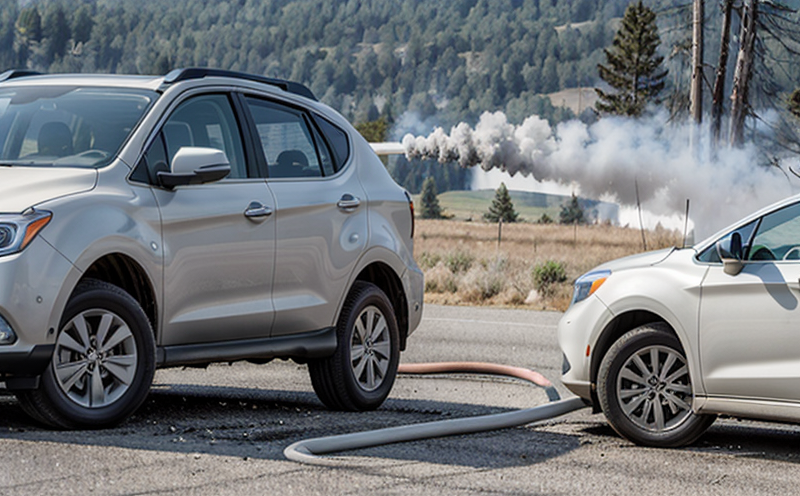Toxic Gas Emission Testing for Emergency Escape Routes
Emergency escape routes are critical components of any facility's safety infrastructure. The integrity and performance of these routes must be ensured to guarantee the safe evacuation of occupants during emergencies. One crucial aspect of this assurance is toxic gas emission testing, which evaluates the potential hazards posed by gases that may be released from materials used in emergency escape route construction or maintenance.
These tests are particularly important for materials like insulation, wall coverings, and furniture that could potentially release harmful chemicals when exposed to high temperatures. The testing process not only helps identify hazardous emissions but also ensures compliance with international standards such as ISO 13950-2 and EN 451.
The results of these tests are essential for making informed decisions about the selection, specification, and implementation of materials that contribute to a safe evacuation environment. By understanding the toxic gas emissions from materials used in emergency escape routes, facilities can take proactive measures to mitigate risks and enhance occupant safety.
During testing, samples are subjected to controlled conditions that simulate real-world scenarios where high temperatures might be encountered during an emergency. The apparatus used for these tests includes specialized chambers capable of generating controlled heat sources, which allow the materials to release any gases present. This process is crucial in determining whether the materials meet safety standards and can be safely used within a facility.
The acceptance criteria for toxic gas emission testing are stringent, ensuring that only materials deemed safe for use in emergency escape routes pass these tests. These criteria often include limits on specific chemical compounds or total volatile organic compound (TVOC) levels that the material may emit under test conditions. Compliance with such standards is not just a matter of safety but also an essential step towards regulatory compliance and peace of mind.
Understanding the real-world applications of this testing is equally important for both manufacturers and facility managers. For instance, if a particular type of insulation used in emergency escape routes emits toxic gases when exposed to fire, it could pose significant risks to occupants during an evacuation. Such knowledge allows facilities to make informed decisions about material selection and can lead to safer environments.
Scope and Methodology
| Parameter | Description |
|---|---|
| Test Sample Preparation | Samples are cut from the materials to be tested, ensuring they represent the full range of conditions under which the material will be used. |
| Temperature Control | The testing chamber is set to simulate actual fire conditions that might occur during an emergency. The temperature can reach up to 800°C (1472°F). |
| Gas Sampling and Analysis | Gas samples are collected from the chamber using advanced analytical instruments capable of identifying even trace amounts of toxic compounds. |
| Data Recording and Reporting | All data is meticulously recorded, and a comprehensive report detailing compliance or non-compliance with specified standards is generated. |
Benefits
Ensures Compliance: Adherence to international standards like ISO and EN, reducing the risk of legal penalties for non-compliance.
Promotes Safety: Identifies potential hazards early, allowing facilities to take proactive measures in material selection.
Enhances Reputation: Demonstrates a commitment to safety and quality, which can be a significant advantage in attracting customers or clients.
Reduces Risk of Liability: By understanding the toxic emissions from materials, facilities can minimize their liability for potential health risks.
Supports R&D: Provides valuable data that can inform research and development efforts to create safer materials in the future.
Why Choose This Test
Choosing toxic gas emission testing for emergency escape routes is a prudent decision due to its numerous advantages. Firstly, this test ensures that all materials used in these critical areas meet stringent safety standards, thereby protecting occupants from potential hazards during emergencies. Secondly, it helps facilities avoid costly mistakes by identifying problematic materials early on, allowing them to make informed decisions about their use.
Furthermore, compliance with relevant international standards is a must for many organizations operating within regulated industries. By choosing this test, they not only safeguard the well-being of their employees but also uphold their reputation as responsible and safety-conscious entities. Additionally, conducting these tests can significantly reduce liability risks by preemptively addressing potential issues.
The data obtained from such testing is invaluable for ongoing research and development efforts aimed at creating safer materials in the future. This information provides valuable insights into material behavior under extreme conditions, which can be used to improve designs and specifications.





